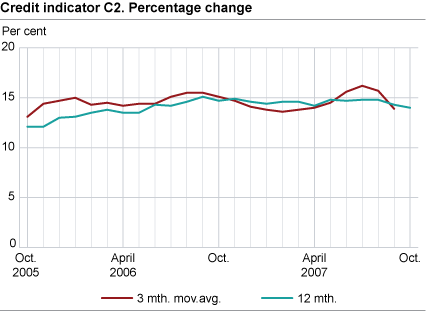Content
Published:
This is an archived release.
Lower growth in gross domestic debt
The twelve-month growth in the credit indicator C2 was 14.0 per cent to end-October, down from 14.3 per cent to end-September. Non-financial enterprise and household growth rates fell, but this was partly offset by slightly higher growth rates in local government.
Household gross domestic debt was NOK 1 709 billion at end-October. The twelve-month growth was 11.6 per cent to end-October, down from 11.8 per cent to end-September. Thus the growth rate has fallen in each of the last three months. The average twelve-month growth in household gross domestic debt in the first ten months of this year was 12.0 per cent, compared to an average growth of 13 per cent during 2006. The growth in household gross debt to end-October 2007 was once again higher than the growth in household money supply (9.4 per cent).
Reduced growth rate in non-financial enterprise debt
Non-financial enterprise gross domestic debt was NOK 979 billion at end-October. The twelve-month growth was 19.1 per cent, down from 20.0 per cent to end-September. The growth rate thus fell below 20 per cent for the first time since July 2006. The growth in enterprise money supply rose to 25.5 per cent to end-October according to the M2 statistics ; and continues to be higher than the growth in enterprise debt. The large growth in non-financial enterprise gross debt and money supply is related to the continued strong growth in the Norwegian economy.
Portfolio shifts and IFRS
71 per cent of the general public gross domestic debt of NOK 2 886 billion at end-October consists of bank loans. The twelve-month growth in bank loans fell from 16.7 per cent to end-September to 15.6 per cent to end-October. The twelve-month growth in credit from mortgage companies increased from 13.3 to 17.1 per cent and growth in credit from finance companies fell from 9 per cent to 7.3 per cent. The growth rates are influenced by shifts in loan portfolios between these institutions. The accounting standard IFRS, which was implemented in March this year, may also lead to more fluctuations in the data.
| Aug 2007 | Sep 2007 | Oct 2007 | |||||||||||||||||||||||||||||||||||||
|---|---|---|---|---|---|---|---|---|---|---|---|---|---|---|---|---|---|---|---|---|---|---|---|---|---|---|---|---|---|---|---|---|---|---|---|---|---|---|---|
| 12 mth total | 14.8 | 14.3 | 14.0 | ||||||||||||||||||||||||||||||||||||
| 3 mth mov.avg.tot | 15.7 | 13.9 | |||||||||||||||||||||||||||||||||||||
| 12 mth households | 12.0 | 11.8 | 11.6 | ||||||||||||||||||||||||||||||||||||
|
C2 is an approximate measure of the size of the gross domestic debt of the general public (households, non-financial enterprises and municipalities) in NOK and foreign currency. Statistics Norway also compiles the credit indicator C3, which in addition to C2 (the public’s domestic gross debt) includes the public’s external loan debt. Most of the public’s external loan debt refers to non-financial enterprises. The C3 statistics are published approximately one month later than the C2. See http://www.ssb.no/english/subjects/11/01/k3_en/ |
The statistics is now published as Credit indicator.
Contact
-
Statistics Norway's Information Centre
E-mail: informasjon@ssb.no
tel.: (+47) 21 09 46 42

